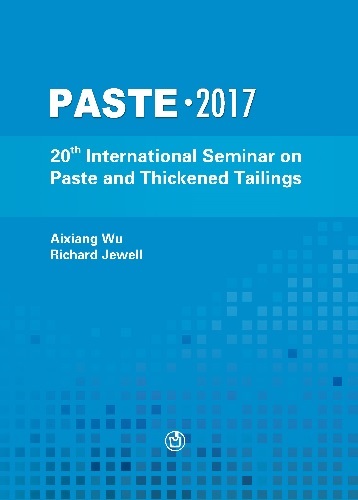Digital imaging and laser measurement of paste pipe wear

|
Authors: Santarossa, M; Marchant, R |
DOI https://doi.org/10.36487/ACG_rep/1752_11_Santarossa
Cite As:
Santarossa, M & Marchant, R 2017, 'Digital imaging and laser measurement of paste pipe wear', in A Wu & R Jewell (eds), Paste 2017: Proceedings of the 20th International Seminar on Paste and Thickened Tailings, University of Science and Technology Beijing, Beijing, pp. 95-104, https://doi.org/10.36487/ACG_rep/1752_11_Santarossa
Abstract:
The wear of paste fill pipes is affected by a range of factors and can be difficult to predict. Tailings properties, paste mixture, pipe material and geometry as well as human factors regarding the operation of plant may all affect pipe wear. For this reason monitoring the condition of pipework through regular inspection is good practice in any paste fill infrastructure maintenance program. Recent advances in digital imaging recognition algorithms make it possible to perform real-time internal pipe measurement and image-capture to quickly collect valuable pipe condition data with minimal plant downtime. A paste pipe measuring instrument, called HoloSense, which can be lowered down vertical paste pipes is described here and examples are given of measurements from regular inspections on paste fill borehole pipes at Newmont’s Tanami Gold Mine since December 2015. The instrument uses a laser source together with a holographic diffraction grating and conical mirror to illuminate the inside of the pipe with a ring of light. This ring is imaged with a centrally located camera and measurements of internal wear are determined automatically in real time and logged for later detailed analysis. The mathematical image analysis system is the main innovation with the instrument and allows measurements of pipe wear to an absolute accuracy of better than 1 mm and a resolution of 0.2 mm. Up to 360 Independent points are measured on the circumference of the ring giving an excellent resolution of wear. In the direction of the pipe axis, measurements are taken typically every 10 mm in a reconnaissance survey where the instrument is lowered down the pipe at its maximum winch speed of 0.3 m/s. By slowing down the winch speed, detailed measurements of highly worn areas give information every 1 mm in the pipe axis direction.
References:
Belem, T. and Benzaazoua, M. 2008, 'Design and application of underground mine paste backfill technology', Geotechnical and Geological Engineering, vol. 26, pp. 147-174.
Bickerstaff, R., Vaughn, M., Stoker, G., Hassard, M. and Garrett, M. 2002, 'Review of sensor technologies for in-line inspection of natural gas pipelines', Sandia National Laboratories.
Hundertmark, H.W. and Davey, A.E. 1981, 'Pipe inspection apparatus', Available: Google Patents.
Maxted, L., Sondex, L., and Hazel, P. 1995, 'Advances in multi-finger caliper technology and data acquisition', Offshore Technology Conference.
Yin, J., De Gyves, J.P. and Lu, M. 1994, 'In-place detection of internal and external corrosion for underground casing pipes', Proceedings of the IEEE International Conference on Industrial Technology, pp. 789-793.
© Copyright 2025, Australian Centre for Geomechanics (ACG), The University of Western Australia. All rights reserved.
View copyright/legal information
Please direct any queries or error reports to repository-acg@uwa.edu.au
View copyright/legal information
Please direct any queries or error reports to repository-acg@uwa.edu.au